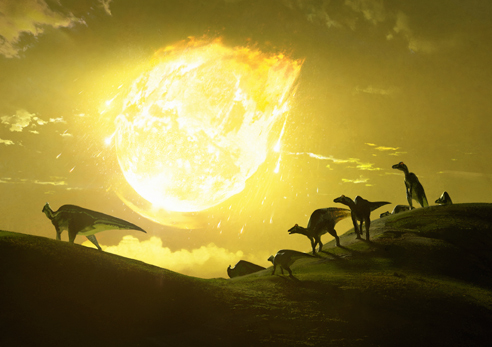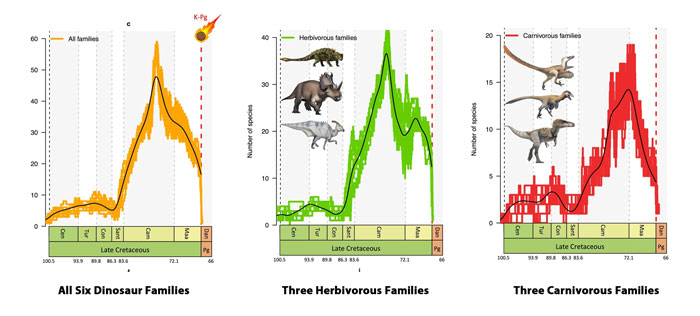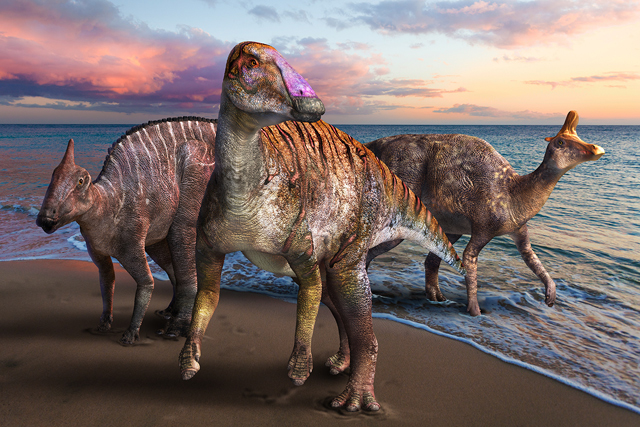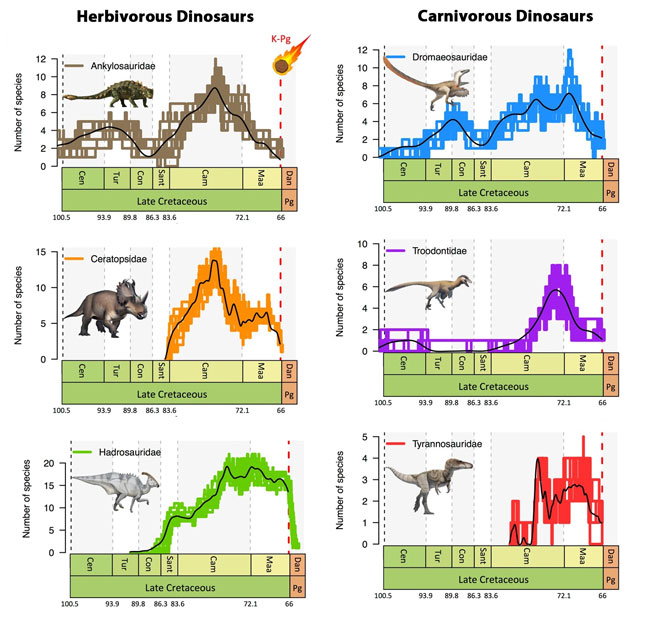New research examining the number of different types of non-avian dinosaur roaming the planet 66 million years ago, suggests that these dinosaurs were in decline long before the extra-terrestrial impact that led to their ultimate extinction.
Researchers including Professor Michael Benton (Bristol University), Fabien Condamine and Guillaume Guinot (Université de Montpellier) along with Phil Currie (University of Alberta), compiled an extensive list of dinosaur fossils associated with the last few million years of the Mesozoic. They then subjected the data to sophisticated statistical analysis and concluded that across the six main types of dinosaur studied (three herbivorous groups and three carnivorous groups), the non-avian dinosaurs were in general decline.

Speciation-extinction Dynamics
The six different types of non-avian dinosaur studied were:
- Tyrannosauridae (big meat-eaters such as Tyrannosaurus rex, Gorgosaurus and Daspletosaurus.
- Dromaeosauridae – swift predators such as Velociraptor, Zhenyuanlong and Dromaeosaurus.
- Troodontidae closely related to the dromaeosaurs – dinosaurs such as Stenonychosaurus and Latenivenatrix.
- Ceratopsidae horned dinosaurs such as Triceratops and Pachyrhinosaurus.
- Ankylosauridae the club-tailed, armoured dinosaurs such as Euoplocephalus, Scolosaurus and Ankylosaurus.
- Hadrosauridae the duck-billed dinosaurs such as Edmontosaurus, Hadrosaurus and Corythosaurus.
The statistical analysis comparing speciation rates to extinction rates revealed that the number of dinosaur species was in steep decline from around 10 million years before the extra-terrestrial impact event.

Global Climate Cooling and the Success of the Hadrosaurs
The sophisticated Bayesian analysis indicates that both herbivorous and carnivorous dinosaurs declined and that this was a world-wide phenomenon. Some types of dinosaur declined sharply towards the end of the Cretaceous, for example the Ankylosauridae and the horned dinosaurs (Ceratopsidae). Of the six families studied, only one family, the Troodontidae shows a very small decline. This decline took place in the last five million years of the Cretaceous.
The team also found a link between the decline of herbivores and the decline of the carnivores. Plant-eaters declined first and this led shortly afterwards to a decline in the genera of meat-eating dinosaurs. It is presumed that the reduction in prey led to the demise of carnivorous dinosaurs.
The reduction in the number of armoured and horned dinosaurs might be linked to the number of hadrosaur species identified. Duck-billed dinosaurs could have outcompeted other herbivores leading to a decline in the total number of herbivore types present in an ecosystem.

The research team continued conducting a statistical analysis to test theories as to why this decline occurred. They concluded that global cooling could have been a major factor in the extinction of many different types of dinosaur and the reduction in the number of new species evolving to re-populate ecosystems. The Earth cooled by around 7-8 degrees Celsius at the end of the Cretaceous. In contrast, periods of sustained global warming in the Early Cretaceous led to a rise in the diversity of the Dinosauria.

The scientific paper: “Dinosaur biodiversity declined well before the asteroid impact, influenced by ecological and environmental pressures” by Fabien L. Condamine, Guillaume Guinot, Michael J. Benton and Philip J. Currie published in Nature Communications.
Visit the Everything Dinosaur website: Everything Dinosaur.






Leave A Comment